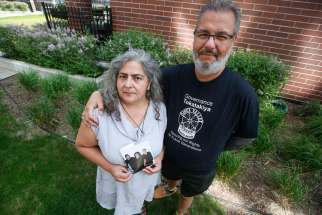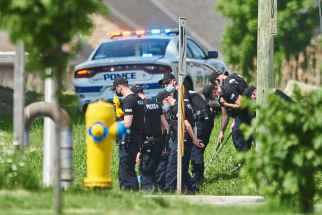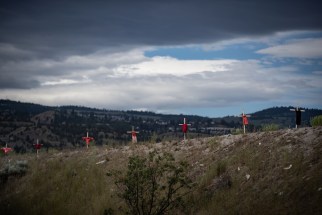On the front lines, behind the scenes Respiratory therapists' efforts to keep COVID-19 patients breathing often go unheralded
Read this article for free:
or
Already have an account? Log in here »
To continue reading, please subscribe:
Monthly Digital Subscription
$0 for the first 4 weeks*
- Enjoy unlimited reading on winnipegfreepress.com
- Read the E-Edition, our digital replica newspaper
- Access News Break, our award-winning app
- Play interactive puzzles
*No charge for 4 weeks then price increases to the regular rate of $19.00 plus GST every four weeks. Offer available to new and qualified returning subscribers only. Cancel any time.
Monthly Digital Subscription
$4.75/week*
- Enjoy unlimited reading on winnipegfreepress.com
- Read the E-Edition, our digital replica newspaper
- Access News Break, our award-winning app
- Play interactive puzzles
*Billed as $19 plus GST every four weeks. Cancel any time.
To continue reading, please subscribe:
Add Free Press access to your Brandon Sun subscription for only an additional
$1 for the first 4 weeks*
*Your next subscription payment will increase by $1.00 and you will be charged $16.99 plus GST for four weeks. After four weeks, your payment will increase to $23.99 plus GST every four weeks.
Read unlimited articles for free today:
or
Already have an account? Log in here »
Hey there, time traveller!
This article was published 07/06/2021 (1650 days ago), so information in it may no longer be current.
Melissa Burdy is one of the phantom heroes of the pandemic.
She works 12-hour shifts keeping critically ill COVID-19 patients alive and breathing, but few will ever have any conscious contact with her. By the time the respiratory therapist is helping them, they’re too sick for introductions.
“We see you when you’re really, really, really sick and needing to go on a ventilator,” she said. “People don’t really remember us, because they’re that sick. And then by the time you’re kind of better and can really be awake, we’ve pulled the (breathing) tube and you’re doing better and you’re OK to leave. We don’t see you again.”
The former teacher, who switched careers 14 years ago, knows the fragility of lungs, the randomness of who succumbs to viruses and what it’s like being run off your feet every shift.
“We’re not used to this many people dying and how many people we just can’t do anything (more) for. They just, all of a sudden, die.”

Sometimes the lung stiffens and the patient can no longer breathe effectively. The lung becomes like scar tissue. “We can’t fix that. Or something else goes — your heart is affected because of everything and you just end up with multi-system failure.” This has been happening since late fall.
“It’s just exhausting for everyone right now because of the sheer volume and the pace.” But she loves her job and the teamwork at the Health Sciences Centre.
“Everyone’s trying to do whatever they can to support everyone,” said the respiratory therapist, who knows many aren’t familiar with her “RT” position.
“We’re kind of the specialists of breathing,” Burdy said. Their three years of training encompasses a lot — from helping those with asthma and chronic obstructive pulmonary disease (COPD) to trauma and COVID-19 patients who can’t breathe on their own.
They assist the physician with intubation — putting the breathing tube into a patient who is in an induced coma.
“Once the tube is in, we deal with the rest of it — all the ventilator management of people’s breathing mechanics and how their lungs are. Everyone’s different. So it’s our job to figure out how to best ventilate them without causing damage. Because if you’re not doing it right, you damage the lungs.”
Before the COVID-19 vaccine, they could also damage themselves and their families.
”We’re at the head of the bed for everything — you have to make sure the tube’s in right and you’re adjusting things and listening, and all around my face is this COVID cloud and I’m thinking ‘I hope my PPE is good’,” said the married mother of two.It’s the pace. It just doesn’t stop. Everyone’s just sicker. You don’t get to sit, ever. It works out to be like a 13-hour shift, that’s just ‘Go!’ from when you walk in the door.” – Melissa Burdy, respiratory therapist at Health Sciences Centre
“Now that we’re vaccinated you feel a little bit better but, at the beginning, it was scary. You’re coming home to your family and thinking ‘I hope I was covered properly.'”
The third wave is less scary than the second, but worse, she said.
“It’s the pace. It just doesn’t stop. Everyone’s just sicker. You don’t get to sit, ever,” she said after walking 16,000 steps in one shift. And it’s rarely just 12 hours, when you factor in the reports that have to be taken and given before and after a shift. “It works out to be like a 13-hour shift, that’s just ‘Go!’ from when you walk in the door.”
And it’s not easy work. If a patient needs to be “proned” — turned face-down — the RT needs a half a dozen people to help while they make sure the tube stays in place and there isn’t a leak.
“Sometimes patients don’t do well when you flip them over, so you’re in there for another half-hour adjusting the ventilator to try to re-expand their lungs,” said Burdy.
The third wave is more merciless and unpredictable.
“It’s just everyone’s sick and they just get sick so fast and it’s just shocking. You see this progression and for some reason, some people are fine, and some people are not — and why? I can’t tell you. This guy’s OK. Next to him is someone with pretty much the exact same history and he’s not good at all and may die. And the other guy’s going to be OK to the point that he can leave ICU,” she said.
“There are much younger people that maybe don’t have as many other co-morbidities as the 70-year-olds and 60-year-olds, but they’re still just as sick, needing to be flipped over, staying on the ventilator for weeks and maybe ending up with a trach at the end.” A tracheotomy is an opening made in the throat to help deliver oxygen to the lungs.
“It’s not just COVID-19 we’re dealing with. We are a busy hospital.” HSC is Manitoba’s main trauma centre for everything from car crashes to stabbing victims.
“We’re not used to this many people dying and how many people we just can’t do anything (more) for. They just, all of a sudden, die.” – Melissa Burdy, respiratory therapist at Health Sciences Centre
Recently she spent an entire shift in emergency when five patients arrived needing to be intubated — just one of whom had COVID-19. “You don’t sit down. You’re always in that full PPE constantly and that’s exhausting in itself — of having a mask on and the gown and gloves and goggles and the hat.”
Burdy said she doesn’t feel bad for herself — her sympathy is for nurses.
“I can’t even get into how those guys are running into the ground with the amount of stuff they’re expected to do,” not to mention the emotional toll.
“The nurses are the ones that are making these connections and losing people over and over and over again. We don’t deal with it as much. “
Fast-tracking 13 respiratory therapy grads in their final year so they could begin helping out on the front lines last week has relieved some of the pressure, Burdy said. So has transporting ICU patients with COVID-19 out of Manitoba.
“If we weren’t able to do that, I don’t know what the heck would have happened. I don’t even know how how on earth we would have managed.”
She tracks the daily COVID-19 bulletins to see how many new ICU patients to expect. She remembers May 20 when a record 603 new cases were reported.
“I think we all just get a little crushed at work when we see that because we know, ‘OK, it’s coming’. They get sicker faster — and more sick — with these variants. We just hope that the numbers keep going down and that people keep getting vaccinated. This can’t last forever, right?”
She’s not giving up.
“I still enjoy what I do. I think every day is a learning experience. I still some days think, ‘Oh my God, I’m exhausted.’ But I feel like I’ve made a difference or I hope I’ve made a difference. I’ve kept someone alive longer than they may have. And when you do extubate someone — when you pull the tube out — they look at you and they’re so happy. You hope they’re going to stay OK.
“Sometimes you extubate them, they look great and two days later, they’re not.”
carol.sanders@freepress.mb.ca

Our newsroom depends on a growing audience of readers to power our journalism. If you are not a paid reader, please consider becoming a subscriber.
Our newsroom depends on its audience of readers to power our journalism. Thank you for your support.
History
Updated on Tuesday, June 8, 2021 10:59 AM CDT: fixes typo in cutline






.jpg?h=215)
